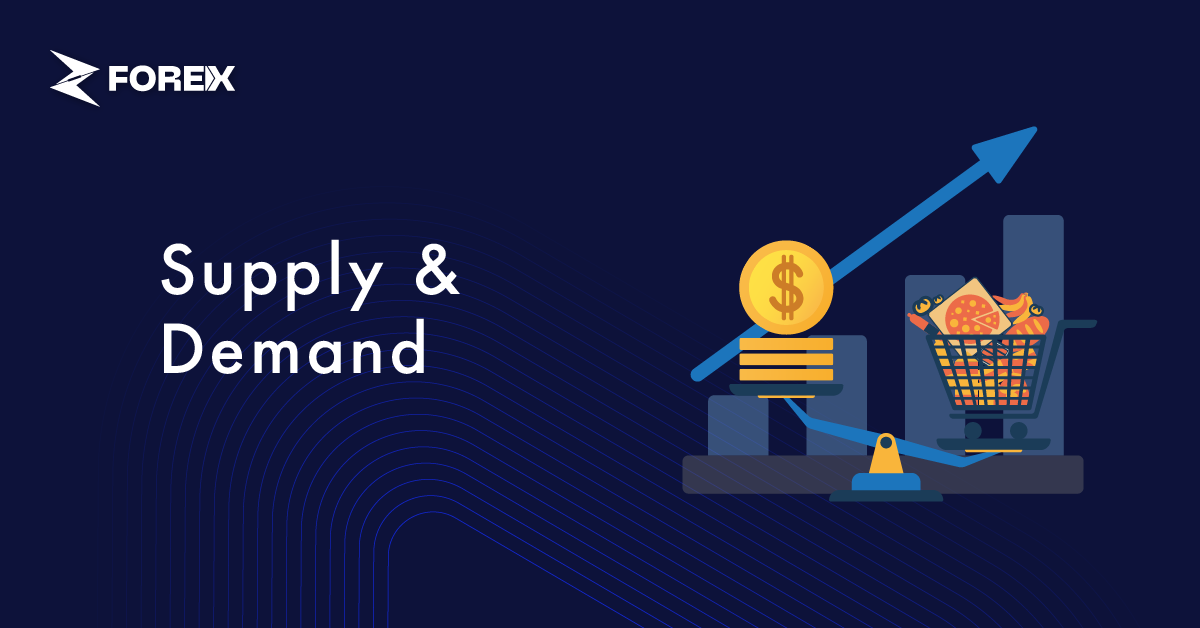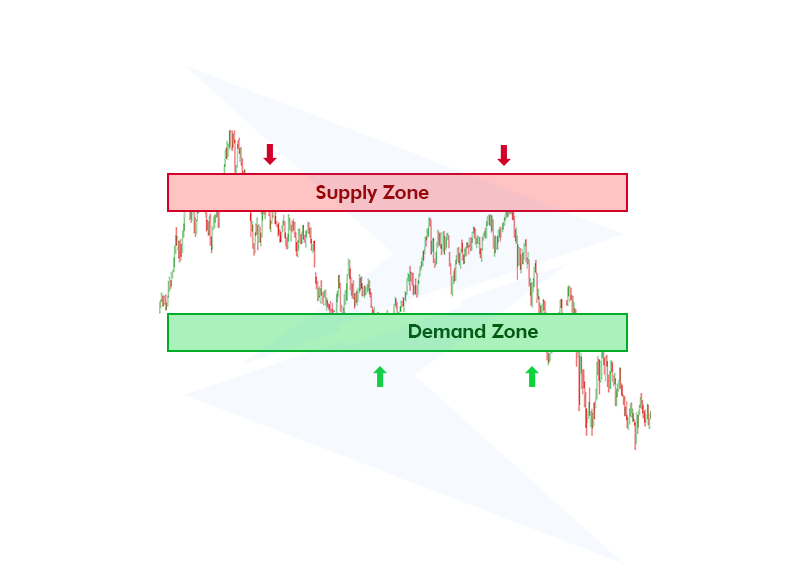
Supply and demand are among the fundamental dynamics of the economy and finance. As one of the most essential concepts for understanding how markets function, the price of any good or service in the market is shaped by the balance of supply and demand. They not only determine the prices of goods and services but also influence production quantities, trade volumes, and even economic relations between countries.
This balance is directly related to how much buyers demand and how much sellers supply. When demand increases and supply remains constant, prices are expected to rise; conversely, if supply increases while demand remains constant, prices may tend to decrease. This simple equation generally holds true in trading operations as well.
Supply refers to the quantity of a particular asset made available in the market. High supply indicates that there are numerous sell orders at a specific price level, signaling that strong demand is required to surpass this level.
For example, in the forex market, the supply of a particular currency can increase or decrease depending on various factors such as central bank monetary policies, interest rates, and foreign exchange reserves. A country's central bank may increase currency supply by printing more money or selling foreign exchange reserves, which can lead to a decrease in the currency's value.
Traders analyze supply levels to make predictions about the direction of an asset's price movement. For instance, if a trader notices that a currency pair is approaching a resistance level where supply is concentrated, they might consider that it could be difficult for prices to break through this level and might anticipate a potential pullback.
Demand, on the other hand, refers to the desire and buying power to purchase an asset at a specific price level in financial markets. High demand is interpreted as a significant number of buy orders at a certain price level.
For example, if a trader observes that a currency pair is approaching a support level with high demand, they may assess the possibility of prices bouncing upwards from this level.
Prices in markets are shaped by the balance between supply and demand. When the supply of an asset exceeds its demand, meaning that there is an abundance of the asset in the market while demand remains low, prices generally tend to decrease. This is because sellers may have to lower prices to attract buyers due to insufficient demand.
Conversely, when demand exceeds supply, meaning that there is high interest in a particular asset and supply is limited, prices tend to rise. In this scenario, buyers may be willing to pay higher prices to acquire the limited asset.
In dynamic markets like Forex, the balance of supply and demand is a critical factor for understanding short-term price movements. Central bank policies, economic data, and global events are external factors that can impact supply and demand, leading to sudden changes in currency exchange rates.
Additionally, supply and demand play a significant role in determining the overall trends in markets. In the long term, a strong increase in demand can lead to a continuous rise in the value of an asset, while consistently high supply can cause a lasting decline in an asset's value.
The main factors affecting supply can be summarized as follows:
The factors affecting demand are as follows:
When supply is higher than demand, prices in the market generally tend to decline. This situation means that sellers must compete more aggressively to sell their assets because the supply of assets in the market is sufficient to meet the demand.
Excess supply forces sellers to lower prices, as buyers leverage the surplus to negotiate lower offers, using the pressure on sellers who are eager to offload their assets.
Sometimes, excess supply can lead to sudden and sharp declines in the markets. Such scenarios may increase the tendency of investors to exit the market, which can further drive prices down. Additionally, in situations of high supply and low demand, liquidity can decrease, making it more difficult to execute trades in the market.
In a market where supply exceeds demand, prices often tend to increase. Because there are more bidders vying for fewer assets, buyers are compelled to make greater offers. As a result, this may cause prices to rise quickly. These price hikes become more noticeable, particularly when supply is constrained and demand is high.
Demand-over-supply situations usually cause asset values to rise quickly, luring investors to purchase at greater prices. High demand and low supply can also improve market liquidity, which facilitates quicker and easier transaction execution.

Supply and demand zones are specific levels where prices typically react. Supply zones are levels where prices often pause or reverse as they move downward from a higher level. These are areas where sellers exert pressure on the market, causing prices to decline. They are generally found near resistance levels.
Demand zones, on the other hand, are levels where prices often pause or begin to rise as they move upward from a lower level. These zones are usually located near support levels and indicate where buyers are entering the market.
Need more information about support and resistance? Please check the relevant article.
How to identify supply and demand zones in Forex?
To identify supply and demand zones, first, you need to determine the price levels where significant reactions have occurred in the past. Supply zones are areas where the price has stalled or reversed when moving downward from above. Demand zones, on the other hand, are levels where the price finds support and starts to rise when moving upward from below. These zones typically manifest as prominent peaks and troughs on the chart.
When does an excess supply lead to a price decline?
Excess supply leads to a price decline when the demand for a particular asset is low while the supply is high. In such a situation, sellers must compete to sell their assets, while the number of buyers remains limited. Sellers are forced to lower their prices to attract buyers, leading to a general downward movement in market prices.
How is supply and demand analysis used in trading strategies?
Traders shape their trading strategies by selling at supply zones and buying at demand zones. Supply-demand analysis helps predict future market movements and allows traders to manage their risks. Since supply and demand zones are considered levels where prices are likely to react, they are also used to determine stop-loss and take-profit points.
How is the supply-demand balance disrupted?
The supply-demand balance can be disrupted by changes in market conditions, central bank policies, economic data, geopolitical events, or market sentiment. For instance, a factor that increases supply can cause prices to fall, even if demand remains constant. Similarly, a sudden increase in demand can drive prices up quickly if the supply remains steady. Such imbalances can lead to sharp and sudden price movements in the markets.
How are supply and demand zones drawn?
Supply and demand zones are typically drawn at levels where prices have shown significant reactions. To identify a supply zone, you look for an area where the price peaked and then quickly declined. For a demand zone, you look for an area where the price dipped and then showed a strong rise. These zones are marked on the chart to monitor how prices may react to these levels in the future.
How is trend following done with supply and demand analysis?
To determine whether a trend will continue or reverse, attention should be paid to the supply and demand zones. For example, in an uptrend, if demand zones are consistently tested and held, it indicates the trend is strong. However, if supply zones are frequently tested and prices pull back from these areas, it may suggest the trend is weakening and a potential trend reversal is approaching.
What are the most common mistakes in supply and demand analysis?
One of the most common mistakes in supply and demand interpretation is incorrectly identifying these zones. Mistaking random price movements for supply or demand zones can lead to misleading signals. Additionally, relying solely on supply-demand without considering other technical analysis indicators can be risky.
 Precious Metals Ratios Against Gold
Precious Metals Ratios Against Gold
Learn what precious metals ratios mean. See what gold-silver, gold-platinum, gold-palladium, and gold-copper ratios tell traders.
Detail How to Share Access to a cTrader Account
How to Share Access to a cTrader Account
Learn how to share access to another cTrader account with a step-by-step guide for web, desktop, and the cTrader mobile app.
Detail How to Use Risk-Reward Tool in cTrader
How to Use Risk-Reward Tool in cTrader
What is the Risk-Reward tool in cTrader and how to use it. Learn with practical examples.
DetailThen Join Our Telegram Channel and Subscribe Our Trading Signals Newsletter for Free!
Join Us On Telegram!